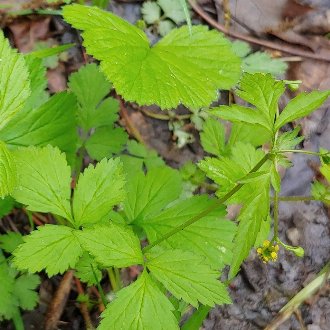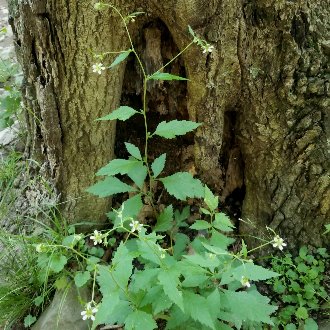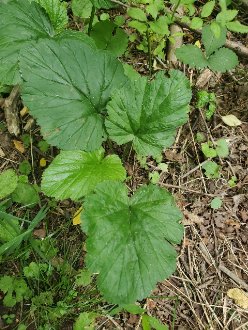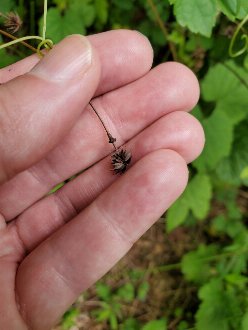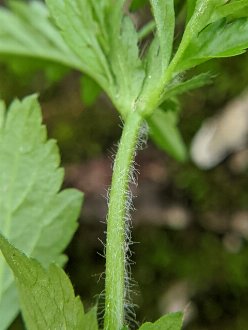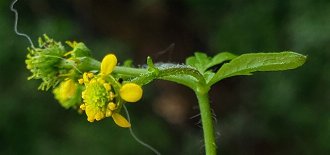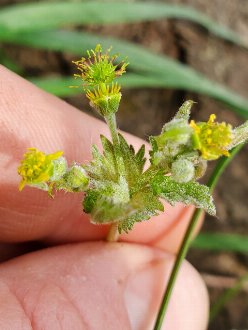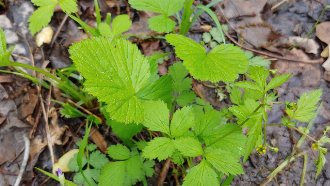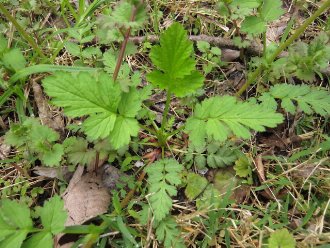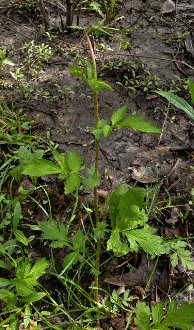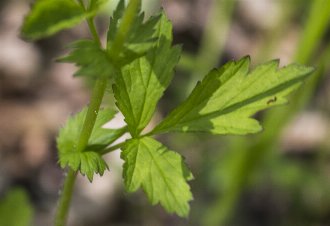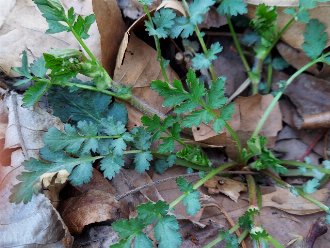Spring Avens (Geum vernum (Raf.) Torr. & A. Gray)
↑Summary
A perennial with inconspicuous flowers, native to the central to eastern US, completing most of its growth in the spring.
↑Range - Expand
| Legend | Color |
| Native | |
| Native or Not Present | |
| Native or Expanded | |
| Native or Expanded or Not Present |
This tentative map is based on our own research. It may have limited data on Canada and/or Mexico, and there is some subjectivity in our assignment of plants as introduced vs. expanded. Read more in this blog post.
Although this plant occurs somewhere in each of these regions, it may only occur in a small part of some or all of them.
The exact native range of this species is not known but it is generally agreed to be expanding eastward in some places, probably taking advantange of disturbance and a more open canopy in previously forested areas. BONAP and Go Botany both report it as not native to Massachussets. BONAP, FSUS, and Flora of Delaware agree that this species is not native to New Castle County, DE, but BONAP and FSUS report it as native to Virginia. However, vaplantatlas.org reports it as "Uncertain" throughout all Virginia. Regardless of where you make the cutoff, its new range is directly adjacent to and well-connected to its native range so there is no doubt as to marking it Expanded in our scheme.
↑Similar Plants
↑Habitat
Found on disturbed sites in a variety of moist, rich, deciduous woodlands and semi-wooded habitats, including bottomland forests, rich upland woods, woodland borders or clearings, bases of cliffs, and shaded streambanks and seeps. Also found in anthropogenic habitats including woodland paths, shaded roadsides, and richer, shaded portions of abandoned fields.
Prefers dappled sunlight to light shade, moist to mesic conditions, and nutrient-rich loamy soil. Prefers sites where disturbance has removed vegetation and exposed the soil. Tolerates and may even benefit from deer overbrowsing.
Tends to be relatively infrequent and scattered throughout most of its range, but tends to be locally common and form large populations where it does occur. Overall, this species has a narrower range of habitat tolerances than most other Geum species.
↑Life Cycle
This species is an herbacenous perennial, and specifically, is a perpetual rosette plant. It develops earlier in spring than other Geum species.
First-year plants often grow only as a basal rosette, forming a flowering stem only in their second year. These stems initially proceed horizontally from the rosette, then curving to grow upwards several inches away. At the same time this stem is developing, the plant often grows broad, simple basal leaves that replace the narrower compound leaves from earlier in the season. This change in leaf structure reflects the shift from high light availability to lower light availability before and after trees leaf out in spring.
Flowers appear incrementally during about a 3-week bloom period, with seeds maturing incrementally, most maturing by about the start of summer. The flowering stem eventually dies down but the broad basal leaves persist throughout most of the growing season. Seeds are distributed irregularly; seeds stick to animal fur and clothing, and can be distributed as soon as they mature but in most cases stay on the plant for several months. Because flowering stems are narrower, flimsier, and lower to the ground than other Geum species, seeds that are not distributed by animals often fall to the ground at some point before the next season; in this case the horizontal sprawling of the stem is itself an important mechanism of seed distribution. This phenomenon can cause this species to form clusters or dense colonies on suitable sites.
Later in the growing season, the broad basal leaves die down and plants grow new foliage lower to the ground; the dieback of broad leaves occurs earlier in drier conditions. Some evergreen foliage may persist through the winter, especially in milder winters and on more sheltered sites.
Relative to Geum canadense, this plant flowers and sets seed earlier, relies more on its basal leaves and less on its cauline leaves, and grows less evergreen basal foliage.
We did not find any information on the lifespan of individual plants, nor on its persistence in the seed bank.
↑Faunal Associations
The foliage of spring avens is browsed to an extent by white-tailed deer, but deer usually avoid eating large quantities of it, which can allow it to thrive in heavily browsed areas.
The flowers are primarily pollinated by small bees, including small carpenter bees (Ceratina sp.), sweat bees (Halictidae), cuckoo bees (Nomada sp.), and masked bees (Hylaeus sp.). The Halictidae collect pollen as well as nectar, and the other bees mostly collect nectar. Flies, including hoverflies (Syrphidae) and Tachinid flies (Tachinidae) are less-frequent visitors.
We have not found any information on insects or other invertebrates that eat this plant.
↑Related Plants
Numerous other Geum species overlap with this one in range. It may be closest-related to two primarily western species: old man's whiskers (Geum triflorum), which only has a narrow zone of overlap in southeastern Wisconsin, northeastern Illinois, and southwestern Michigan, and Ross' avens (Geum rossii), which does not overlap or even come close to overlapping with this one in range.
After these, it may be closest-related to yellow avens (Geum aleppicum), purple avens (Geum rivale), and two species that do not occur in North America: Geum reptans, and Geum montanum.
These lists may not be exhaustive as the genetic studies of Geum sp. that we found were not comprehensive.
↑Links & External Resources
• Geum vernum (Spring Avens) | Illinois Wildflowers (About This Site)
• Geum vernum (spring avens) | USDA PLANTS Database (About This Site)
• Geum vernum | Go Botany (About This Site)
• Spring Avens | iNaturalist (About This Site)
• Geum vernum | Biota of North America Project (BONAP) (About This Site)
• Geum vernum | NatureServe Explorer (About This Site)
• Geum vernum | Flora of North America (About This Site)
• Geum vernum | Missouri Plants (About This Site)
• Spring Avens | Maryland Biodiversity Project (About This Site)
• Geum vernum (Raf.) Torr. & Gray (Spring Avens) | Digital Atlas of the Virginia Flora (About This Site)



